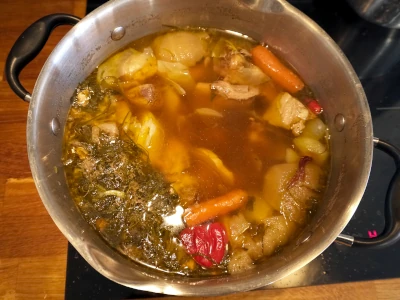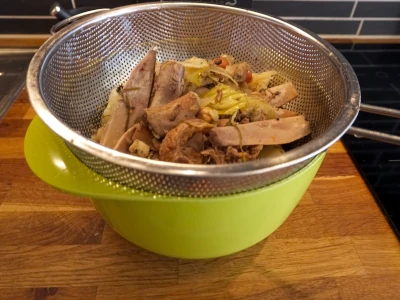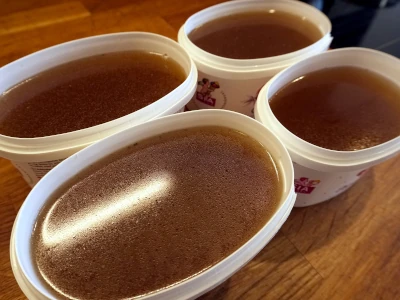An easy and good way to handle leftovers.

I'm nagging about homemade stock in some of my recipes, but why am I so happy about that? Isn't it just as good to buy bouillon cubes and mix them with water?
 Miscellaneous saved leftovers
Miscellaneous saved leftovers
There is absolutely no magic behind making your own stock and of course it is possible to use a purchased bouillon/stock cube that is dissolved in water to achieve a similar effect.
The biggest advantages for me, however, are that I take care of various leftovers that would otherwise have been thrown away, I know exactly what the stock contains so there are no extra additives that I do not want and then a homemade stock is often better as it contains ingredients I normally uses and thus likes. There will also be a certain variation in the taste as I mostly use leftovers and what I have managed to save in a month can differ a lot.
Making your own stock
As previously stated, it is not a difficult thing to make your own stock. Basically, you take your leftovers, pour in the appropriate amount of water and boil everything for an hour. Then strain the "soup" and retain the liquid - done.
 After an hour of boiling
After an hour of boiling
So even if it's easy, it may take some time to prepare. You have to keep in mind to not only automatically throw away the pieces of ingredients that normally end up in the garbage, but instead think through whether it would be a good addition to the next broth. This is a process that can take me several weeks.
Things that work really well to save for the stock boil are e.g. bones from poultry, beef and pork. I usually save these in a jar in the freezer and supplement the contents of that jar with the leftovers of future meals.
A little trick to get even more flavor from e.g. chicken bones is to place them on a plate and cook them in the oven under the grill for a few minutes so that they start to get color. It may sound a bit exaggerated, but I think it makes a difference and that you get more flavor from the bones this way.
En annan smakbomb man kan använda är torkad svamp - det ger en riktigt fyllig umami känsla till buljongen.
 Strain off all large pieces
Strain off all large pieces
Other ingredients that I usually make into a part of my stock are yellow onion, garlic, carrot, chili, ginger and fresh spices. I use a lot of yellow onions in my cooking and there are always a few small pieces left over that I freeze. Should I have any fresh ingredients that for some reason have not been used in time, they will also end up in the freezer.
Of course, you must use common sense here and not choose ingredients that have started to rot or in any way gone bad - they should be thrown away. I'm talking about carrots that may have become a little too soft, but are still edible or fresh spices that are starting to look a bit sad. I also usually save harder parts of e.g. carrots as the base which you do not usually eat - I just remove any soil and dirt to then save these.
Basically, you can use lots of different ingredients and in the stock I took pictures of here, I use, among other things, apple and cabbage that I had in the fridge that day.
 Layer of grease that can be thrown away
Layer of grease that can be thrown away
After cooking, the stock can contain quite a lot of fat. Especially if you use a lot of leftover meat. Normally I choose to remove this.
An easy way to get rid of most of the fat is to place the broth in the refrigerator until it has reached refrigerator temperature. The fat then usually creates a hard layer that floats on top of the rest of the stock. You can then easily scoop away the unwanted fat and throw it away.
After cooling the stock, it is time to portion up and freeze it for future use. I usually give the broth a quick boil and make sure that everything is well mixed and then pour it into suitable containers.
 Finished stock to freeze
Finished stock to freeze
I choose containers that hold about 500 ml (500 grams) so that it fits most recipes I use. It is also the amount that a finished stock/bouillon cube mixed with water will generate which makes it easier to use.
One last thing I tried around a bit with is how much salt I want to add. Previously, I added salt just before I pour the stock into jars as it is easy to taste because I still heat it up a bit quickly. Lately, however, I have chosen to keep the amount of salt quite low and instead add more salt to the finished dish that I use the stock for, but here you can of course do exactly how you want. You just have to keep in mind that the stock does not feel as tasty when you taste it with a small amount of salt.
I mostly use my broth as an ingredient for other dishes such as soups and chilies, but I have also tried to flavor it with more ginger, honey and salt to create a really good ramen.


